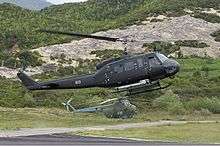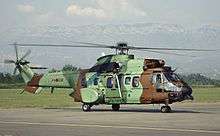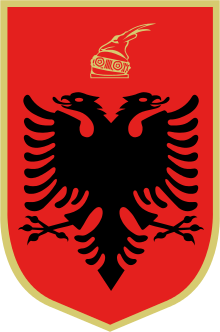Albanian Air Force
| Albanian Air Force Forca Ajrore Shqiptare | |
|---|---|
 Albanian Air Force emblem | |
| Active | 1914–present |
| Country | Albania |
| Allegiance | Republic of Albania |
| Type | Air Force |
| Size | 3,100 personnel |
| Part of | Albanian Armed Forces |
| Equipment | 21 (helicopters) aircraft |
| Commanders | |
| Current commander | Brigadier General Dhori Spirollari |
| Insignia | |
| Roundel |
 |
| Aircraft flown | |
| Helicopter |
AS532 Cougar, EC145, BO-105 AW109, Bell 205, Bell 206 |
The Albanian Air Force (Forca Ajrore Shqiptare, FASH) is the national Air Force of the Albanian military. The headquarters is located in Tirana and it operates two airbases, Kuçovë Air Base and Tirana Air Base.[1]
History
Early History
Military aviation started in Albania in 1914, when the Albanian government ordered three Lohner Daimler aircraft from Austria to form an air force. As a result of the outbreak of World War I, the order was cancelled. Albania did not have the resources to restart the development of a proper Air Force during the 1920s and 1930s. After the establishment of the Albanian Kingdom in 1928, King Zog formed the Royal Albanian Air Corps was formed under the direction of the Royal Albanian Army.
The Royal Air Force, and the rest of Albanian armed forces, were abolished following the Italian invasion of Albania during the Second World War.[2]
Socialist Albania
On 24 April 1951, Following the end of the Second World War, Albania re-established its air force.[3]
An academy was founded in Vlorë in 1962.[3]
Albania cut diplomatic ties with the Soviet Union in 1962, leading to a shift to China for the supply of necessary parts to maintain its MiGs.[4]
After World War II, the Albanian Air Force finally came into existence when Albania was equipped with Soviet aircraft. The first squadron was equipped with Yakovlev Yak-9s. The first jet fighter to enter service was the MiG-15, dating officially the 15th of May 1955, followed by the MiG-17. Some of the MiG-15s were Soviet fighters used and then withdrawn from the North Korean Air Force. The backbone of the Albanian Air Force jet fighters became MiG-19 (NATO code "Farmer"). 12 MiG-19PM were delivered by the USSR in October 1959 and on the same year pilots and specialists were sent in USSR to train with the all-weather interceptor MiG-19 PM. After the collapse of USSR-Albanian relations, significant numbers of Shenyang J-6 fighters (Chinese copy of the MiG-19S), were acquired from China. In the early 1970s, Albania exchanged its lot of Soviet-made MiG-19PM (NATO code "Farmer-E") fighters equipped for beam-riding missiles, with 12, more advanced, Chengdu J-7A fighters (Chinese copy of the Soviet-built MiG-21). Two of them were lost in incidents in the early 1970s, eight had problems with lack of batteries in the early 1980s.
In total, during the 70s and early 80s, the Albanian Air Force was able to deploy 142 airplanes, between Shenyang J-6Cs, 12 Chengdu J-7As, a fighting squadron equipped with MiG-17s, a considerable number of MiG-15 (both BIS and UTI versions), and 4 Soviet-made Il-14 transport aircraft. A squadron of Shijiazhuang Y-5 was deployed in Tirana and the Air Force Academy in Vlora had 2 squadrons of Yak-18 for basic pilot training purposes. The helicopter component consisted in 18 Harbin Z-5 (Chinese copy of Mil Mi-4) helicopters based in Farka Tirana, meanwhile there was a single prototype of a light H-5 bomber based in Rinas.
Due to relations collapse between Albania and the Chinese, maintenance became extremely difficult and the number of deadly incidents involving Mikoyan fighters increased. Despite Albanian efforts and some initial success in repairing the engines of the MiGs, the lack of specific jet fuel forced authorities to start production in a national scale, thus resulting in a low-quality production (The first attempt dates on 1961, when the Kuçova factory produced the special Jet kerosene called TSI). The fuel conditioned the life-time of the jet engines and often was blamed as the main reason of the deadly incidents (35 Albanian pilots lost their life from 1955 to 2005 mainly due to MiG's mechanical failures).
Recent History
Following Fall of communism in Albania in 1990, the air force had 200 jets and 40 helicopters, and four Il-14 transport planes.[4]
During the 1997 uprising in Albania, seven MiGs were destroyed and their parts were stolen.[4]
In the early 90s, in an effort to keep the MiGs flying, the Albanian Air Force received spare parts from Bulgaria and engines from the ex-GDR. By 2004, Albania still had 117 J-6C aircraft, although mostly were not operational and only 12 Chengdu J-7A. The Albanian fighter jets were definitively withdrawn from active service in late 2004 after the last deadly incident involving a J-6C during take-off from the military area at Mother Teresa Airport in Tirana.
By 2006, Albania had scrapped over half of its Z-5s and had signed a contract for the delivery of six Bolkow 105s over three years.[5] This expansion allowed air force to operate with 4 Y-5s, 7 B206s, 3 B205s, 6 Bolkow 105s.[5]
Currently, the Albanian Air Brigade does not operate any old Soviet aircraft. Since 2011, 9 Shijiazhuang Y-5 are retired from service.
In 2011, the air force sold four Il-14 transport planes for scrap.[4]
In 2016, 40 retired Albanian military aircraft were prepared for auction at a future date. The aircraft for sale include a military trainer aircraft, the Yak-18, and four types of military jets — MiG-15s, MiG-17s, MiG-19s, and MiG-21s — and four Mi-4 transport helicopters. The government said there has been interest from collectors and museums, and that it will sell another 100 jets if the auction is successful. The funds generated will be used to further modernize the Air Force.[4]
Aircraft
Current inventory
The Albanian Air Force has retired all its fixed wing aircraft and now operates several types of helicopters. Also, close NATO Integration Air defense is no longer a priority for the Albanian military.



.jpg)
| Type | Origin | Role | Variant | In service[6] | Notes |
|---|---|---|---|---|---|
| Helicopters | |||||
| AS532 | France | transport | 4[7] | Additional units were ordered following the crash of an EC 145.[8] | |
| MBB Bo 105 | Germany | light utility | 8 | ||
| AB 205 | Italy | utility | 5 | ||
| AB 206 | Italy | utility | 5 | ||
| AW109 | Italy | light utility | 1 | ||
| EC145 | France | liaison | 3 | Two units were delivered in late 2015.[9] One was lost in an accident in early 2016.[10] | |
Retired aircraft
All Albanian fixed-wing aircraft were withdrawn from active service in 2005.
| Type | Origin | Role | Variant | In service | Notes |
|---|---|---|---|---|---|
| Combat Aircraft | |||||
| Chengdu F-7 | People's Republic of China | fighter / interceptor | F-7A | 11[11] | licensed built MiG-21 |
| Shenyang J-6 | People's Republic of China | fighter | F-6 / FT-6 | 65[11] | licensed built MiG-19 |
| Shenyang J-5 | People's Republic of China | fighter | F-5 / FT-5 | 21[11] | derivative of the MiG-17 |
| Transport | |||||
| Harbin Y-5 | People's Republic of China | transport | 3[11] | placed in storage | |
| An-2 | Soviet Union | transport | 11[11] | placed in storage | |
| Il-14 | Soviet Union | heavy transport | 4[11] | placed in storage | |
| Helicopters | |||||
| Bell 222 | United States | VIP | 222UT | 1[11] | written off in a crash[12] |
| AS350B | France | utility | 3[11] | retired from service | |
| Harbin Z-5 | People's Republic of China | utility | 31[11] | licensed built Mil Mi-4 | |
| Alouette III | France | liaison | 4[11] | retired from service | |
| Trainer Aircraft | |||||
| Nanchang CJ-6 | People's Republic of China | trainer | 8[11] | ||
| Shenyang FT-2 | People's Republic of China | trainer | 24[11] | licensed built MiG-15UTI | |
Deployment of the Albanian Air Force until 2005
| Unit | Type | Location |
|---|---|---|
| 4004 Regiment | 1st Squadron Nanchang CJ-6 Military Aviation Academy | Vlora |
| 2nd Squadron Nanchang CJ-6 Military Aviation Academy | Vlora | |
| 3rd Squadron MiG-15bis, MiG-15UTI | Kucova Berat | |
| 4010 Regiment | 1st Squadron Chengdu J-7A, Shenyang J-5 | Zadrima Lezha |
| 2nd Squadron Shenyang J-6C | Zadrima Lezha | |
| 3rd Squadron Shenyang J-6C | Zadrima Lezha | |
| 4020 Regiment | 1st Squadron Shenyang J-6C, MiG-15bis, Ilyushin Il-14 | Rinas Tirana |
| 2nd Squadron Shenyang J-6C, MiG-15bis, Ilyushin Il-14 | Rinas Tirana | |
| 4030 Regiment | 1st Squadron Shenyang J-6C, MiG-15bis, | Kuçova Berat |
| 2nd Squadron JJ-5, MiG-15bis | Kuçova Berat | |
| 4040 Regiment | 1st Squadron Harbin Z-5 | Farka Tirana |
| 2nd Squadron Z-5 | Farka Tirana | |
| 3rd Squadron Z-5 | Farka Tirana | |
| 4050 Regiment | 1st Squadron Y-5, AS-350, Bell 222/VIP (lost in incident 2006), Mil Mi-8 | Rinas Tirana |
| Ministry of Health Aviation Unit | SA 316 | Tirana Aerodrome |
See also
References
- ↑ Komanda Forcave Ajrore Shqiptare
- ↑ "History of the General Staff of the Armed Forces". Albanian Armed Forces. Retrieved 9 June 2016.
- 1 2 "Air Force History". Albanian Armed Forces. Retrieved 9 June 2016.
- 1 2 3 4 5 Semini, Llazar (6 March 2016). "Albania, once Europe's most isolated country under a 50-year Communist regime, is selling dozens of obsolete Eastern Bloc military jets". U.S. News & World Report. Retrieved 9 June 2016.
- 1 2 Lofting, Chris; Coupland, John. "Albania 2006". http://www.baes.org.uk/. British Aviation Enthusiasts Society. Retrieved 9 June 2016. External link in
|website=(help) - ↑ World Air Forces 2016. Flightglobal International. 2015. p. 11.
- ↑ de Larrinaga, Nicholas. "Albania receives final Cougar helicopter". Jane's Information Group. Archived from the original on 20 November 2014.
- ↑ "Press Release". Albanian Ministry of Defence. 19 June 2016. Retrieved 7 July 2016.
- ↑ "Hapa të tjerë drejt modernizmit të Forcave të Armatosura" [Steps towards modernization of the Armed Forces] (in Albanian). Albanian Armed Forces. 1 November 2015. Retrieved 7 July 2016.
- ↑ "Statement of Chief of General Staff of Albanian Armed Forces Major General Jeronim Bazo". Albanian Armed Forces. 7 April 2016. Retrieved 7 July 2016.
- 1 2 3 4 5 6 7 8 9 10 11 12 "World Air Forces 2004 pg, 42". Flightglobal I. 2004. Retrieved 4 December 2014.
- ↑ "Albanian Government ZA-HOV". airport-data.com. Retrieved 18 December 2014.
External links
| Wikimedia Commons has media related to Air force of Albania. |
